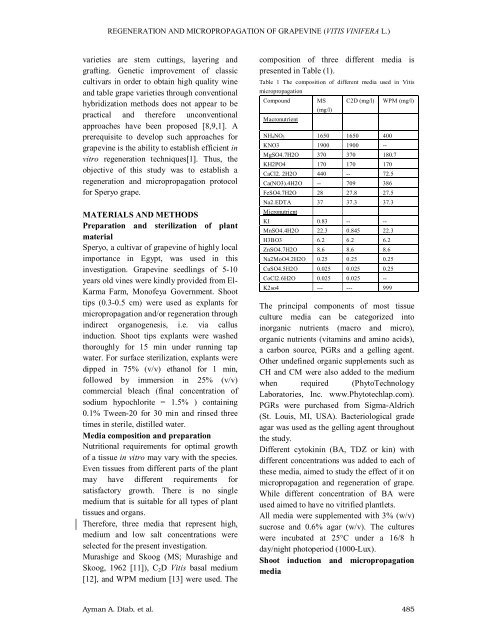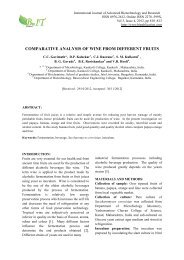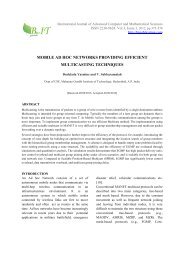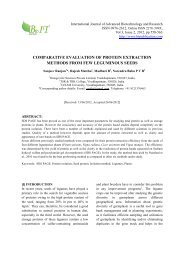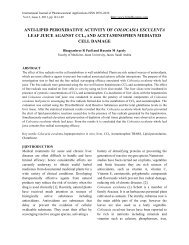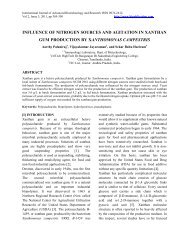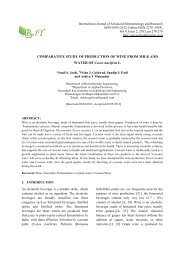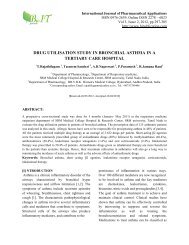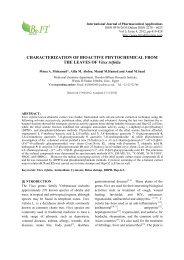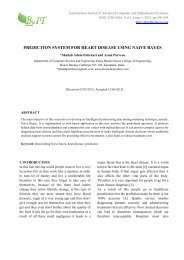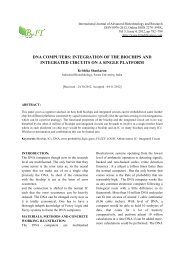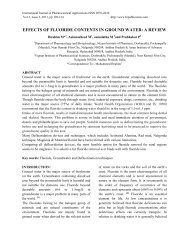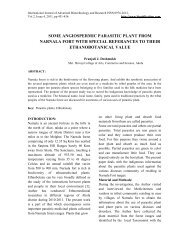regeneration and micropropagation of grapevine - BioIT ...
regeneration and micropropagation of grapevine - BioIT ...
regeneration and micropropagation of grapevine - BioIT ...
Create successful ePaper yourself
Turn your PDF publications into a flip-book with our unique Google optimized e-Paper software.
REGENERATION AND MICROPROPAGATION OF GRAPEVINE (VITIS VINIFERA L.)<br />
varieties are stem cuttings, layering <strong>and</strong><br />
grafting. Genetic improvement <strong>of</strong> classic<br />
cultivars in order to obtain high quality wine<br />
<strong>and</strong> table grape varieties through conventional<br />
hybridization methods does not appear to be<br />
practical <strong>and</strong> therefore unconventional<br />
approaches have been proposed [8,9,1]. A<br />
prerequisite to develop such approaches for<br />
<strong>grapevine</strong> is the ability to establish efficient in<br />
vitro <strong>regeneration</strong> techniques[1]. Thus, the<br />
objective <strong>of</strong> this study was to establish a<br />
<strong>regeneration</strong> <strong>and</strong> <strong>micropropagation</strong> protocol<br />
for Speryo grape.<br />
MATERIALS AND METHODS<br />
Preparation <strong>and</strong> sterilization <strong>of</strong> plant<br />
material<br />
Speryo, a cultivar <strong>of</strong> <strong>grapevine</strong> <strong>of</strong> highly local<br />
importance in Egypt, was used in this<br />
investigation. Grapevine seedlings <strong>of</strong> 5-10<br />
years old vines were kindly provided from El-<br />
Karma Farm, Mon<strong>of</strong>eya Government. Shoot<br />
tips (0.3-0.5 cm) were used as explants for<br />
<strong>micropropagation</strong> <strong>and</strong>/or <strong>regeneration</strong> through<br />
indirect organogenesis, i.e. via callus<br />
induction. Shoot tips explants were washed<br />
thoroughly for 15 min under running tap<br />
water. For surface sterilization, explants were<br />
dipped in 75% (v/v) ethanol for 1 min,<br />
followed by immersion in 25% (v/v)<br />
commercial bleach (final concentration <strong>of</strong><br />
sodium hypochlorite = 1.5% ) containing<br />
0.1% Tween-20 for 30 min <strong>and</strong> rinsed three<br />
times in sterile, distilled water.<br />
Media composition <strong>and</strong> preparation<br />
Nutritional requirements for optimal growth<br />
<strong>of</strong> a tissue in vitro may vary with the species.<br />
Even tissues from different parts <strong>of</strong> the plant<br />
may have different requirements for<br />
satisfactory growth. There is no single<br />
medium that is suitable for all types <strong>of</strong> plant<br />
tissues <strong>and</strong> organs.<br />
Therefore, three media that represent high,<br />
medium <strong>and</strong> low salt concentrations were<br />
selected for the present investigation.<br />
Murashige <strong>and</strong> Skoog (MS; Murashige <strong>and</strong><br />
Skoog, 1962 [11]), C 2 D Vitis basal medium<br />
[12], <strong>and</strong> WPM medium [13] were used. The<br />
composition <strong>of</strong> three different media is<br />
presented in Table (1).<br />
Table 1 The composition <strong>of</strong> different media used in Vitis<br />
<strong>micropropagation</strong><br />
Compound<br />
Macronutrient<br />
MS<br />
(mg/l)<br />
C2D (mg/l)<br />
NH 4NO 3 1650 1650 400<br />
KNO3 1900 1900 --<br />
MgSO4.7H2O 370 370 180.7<br />
KH2PO4 170 170 170<br />
CaCl2. 2H2O 440 -- 72.5<br />
Ca(NO3).4H2O -- 709 386<br />
FeSO4.7H2O 28 27.8 27.5<br />
Na2.EDTA 37 37.3 37.3<br />
Micronutrient<br />
KI 0.83 -- --<br />
MnSO4.4H2O 22.3 0.845 22.3<br />
H3BO3 6.2 6.2 6.2<br />
ZnSO4.7H2O 8.6 8.6 8.6<br />
Na2MoO4.2H2O 0.25 0.25 0.25<br />
CuSO4.5H2O 0.025 0.025 0.25<br />
CoCl2.6H2O 0.025 0.025 --<br />
K2so4 --- --- 999<br />
WPM (mg/l)<br />
The principal components <strong>of</strong> most tissue<br />
culture media can be categorized into<br />
inorganic nutrients (macro <strong>and</strong> micro),<br />
organic nutrients (vitamins <strong>and</strong> amino acids),<br />
a carbon source, PGRs <strong>and</strong> a gelling agent.<br />
Other undefined organic supplements such as<br />
CH <strong>and</strong> CM were also added to the medium<br />
when required (PhytoTechnology<br />
Laboratories, Inc. www.Phytotechlap.com).<br />
PGRs were purchased from Sigma-Aldrich<br />
(St. Louis, MI, USA). Bacteriological grade<br />
agar was used as the gelling agent throughout<br />
the study.<br />
Different cytokinin (BA, TDZ or kin) with<br />
different concentrations was added to each <strong>of</strong><br />
these media, aimed to study the effect <strong>of</strong> it on<br />
<strong>micropropagation</strong> <strong>and</strong> <strong>regeneration</strong> <strong>of</strong> grape.<br />
While different concentration <strong>of</strong> BA were<br />
used aimed to have no vitrified plantlets.<br />
All media were supplemented with 3% (w/v)<br />
sucrose <strong>and</strong> 0.6% agar (w/v). The cultures<br />
were incubated at 25°C under a 16/8 h<br />
day/night photoperiod (1000-Lux).<br />
Shoot induction <strong>and</strong> <strong>micropropagation</strong><br />
media<br />
Ayman A. Diab, et al.<br />
485


